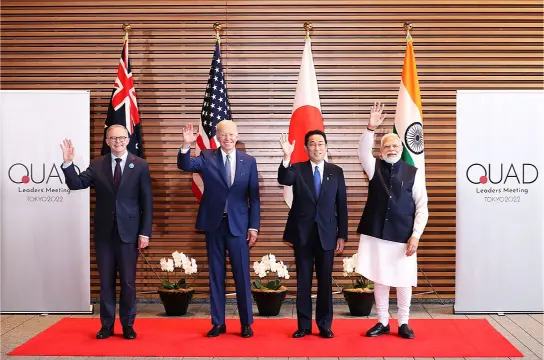The Quadrilateral Security Dialogue includes four countries: India, Japan, Australia, and the United States. Initially, the dialogue was introduced in 2004 as an initiative to relieve the tsunami victims in the Indian Ocean. Fast forward to 2023, it is elevated to the brink of understanding and actively trying to manage the security challenges in the Indo-Pacific. Retired Maj. Gen. Dhruv Katoch of the Indian Army stated, “While the Quad as of now is not a security organization, it has the potential to metamorphose into one,” Quad has progressed significantly quickly.
The diplomacy of the QUAD has shifted and changed over time; it is a flexible association with something to offer each member. India is now at ease within the alliance, accentuating the four countries’ functional collaboration and participating in the alliance for the greater interest of the Indo-Pacific. In contrast, Japan emphasizes the democratic identity of the four countries as a uniting factor and hopes to maintain honesty and trading endeavors with members. The Australian government has been reticent to portray the group as a formal partnership with a scope for trade and commerce based on mutual understanding. The United States, while distracted by Russia’s war with Ukraine, is focused on the challenge of Asia through QUAD to ensure a “free and open Indo-Pacific.”
Since 2021, the QUAD leaders have been more willing to establish a favorable partnership agenda. They are more aligned with their significant stressor, China. The Chinese rise in the last decade is the strongest motivator for this allegiance. China’s growth and rise in the economic and international order are the most noticeable changes in world politics in the last decade. China’s increasingly assertive actions in the Indo-Pacific region are a worrying sign for all QUAD members.
Why is there a conflict of interest in the Indo-Pacific?
Chinese governments have expressed their concern and belief that QUAD is a calculated effort to build an “Asian NATO.” Xi Jinping’s appointment as the general secretary of the Chinese Communist Party in 2012 marked a period of rising hostilities between China and each of the four QUAD member states. Since being appointed president of the People’s Republic of China (PRC) in 2013, Xi has worked to transform China into a more cohesive country than ever, increasingly dominant and assertive in international affairs. China’s relations with the QUAD nations deteriorated in the following years due to Xi’s assertive foreign policy, specifically in the Indo-Pacific.
China’s claim that an ‘Asian NATO’ is the objective of QUAD is because of its growing apprehension that the smaller nations in South Asia might consider joining the QUAD to gather support against China. To illustrate, we could look at South Korea.
South Korea is one of the nations that has expressed an interest in QUAD. Maj. Gen. Jung stated, “The South Korean government’s position has been to maintain a balancing position between China and the U.S”. President Yoon Suk-Yeol stated that to ‘improve its military capabilities, his nation may embrace the Quad grouping.’ President Yoon officially announced that they would examine joining the QUAD, and the South Korean government’s position would change. China believes more nations will join the Quadrilateral security dialogue by seeing the quad partners’ progress.
Many South Asian nations could consider approaching the QUAD arrangement to improve their respective countries’ economic and security orientation while tackling Chinese aggression. China’s misunderstanding with smaller nations in South Asia and along the Indo-Pacific is triggering a shift toward the orientation of Asian politics.
Progression of Asian engagement through QUAD and the role of the United States
Both former U.S. President Trump and the current U.S. President Biden’s administration stated that the Indo-Pacific area would receive more attention, notably as a counterweight to China’s muscular efforts to achieve regional influence. China’s presence and unfriendly participation in the region inspired the four QUAD members in November 2020 to deploy their first joint naval fleet engaging training session in over ten years.
The rise of China provides a unique opportunity that brings nations such as Australia and the U.S. together, which otherwise, due to geographical restrictions, would not have been possible. Indian and Japanese relations with each other and with Australia and the United States have increased significantly over the last decade, a testament to their economic standing worldwide. The U.S. committed to building shared capabilities, entailing the setting up of “new embassies and consulates in Southeast Asia and the Pacific Islands.” Additionally, there is a willingness to strengthen U.S. Coast Guard assistance and presence, focusing on capacity-building, training, and advice.
Maritime security and cooperation with international law, specifically the United Nations Convention on the Law of the Sea (UNCLOS), while ensuring the continuation of freedom of navigation and overflight to guarantee a maritime rules-based order, is high on the Quad agenda. Future-focused initiatives, such as a new Quad fellowship for STEM research, are being launched by the leaders to strengthen regional collaboration. The Indo-Pacific Partnership for Maritime Domain Awareness aims to stop illegitimate fishing and provide assistance in responding to natural disasters and humanitarian crises by enhancing technology and training.
The introduction of “dark ships” and their effect in the region is still to unfold. The waters of the Indo-Pacific might become turbulent as the QUAD nations and China continue to step up and introduce various new initiatives. A media statement released by the White House specified that we have entered a “decisive decade that holds considerable promise and historic obstacles for the Indo-Pacific; the American role in the region must be more effective and enduring than ever.”
